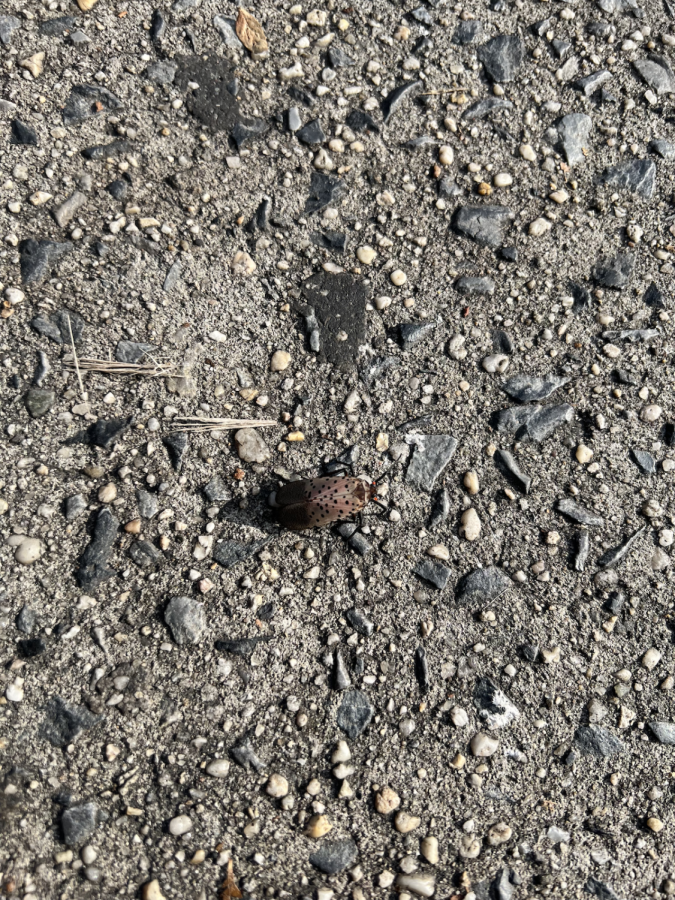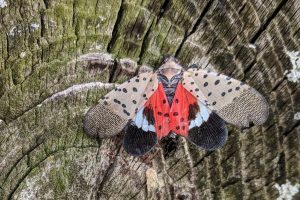Lanternflies in New York: Squash or Spare?
Spotted lanternflies are increasing at a rapid rate in New York City, causing concern about their negative environmental impact
COURTESY OF VALMIRA POPINARA
The spotted lanternfly population has been growing in New York City as temperatures are rising. They are an invasive species that can inhibit photosynthesis in the plants they infest.
October 27, 2022
CORRECTION: A previous version of this article incorrectly spelled Ellen van Wilgenburg’s name as Ellen Van Wilgenburg and misidentified her as a professor at Fordham College at Rose Hill instead of at Lincoln Center. The article stated that van Wilgenburg’s research was to locate the number of lanternflies in New York but has been updated to reflect that her research is meant to study the behavior and chemical ecology of the spotted lanternfly as well as their population genetics. A previous version of this article also said that van Wilgenburg attributed the increase of spotted lanternflies to the previous mild winter and that spotted lanternfly egg masses contain 15-30 eggs. The article now reflects that she speculated on that explanation and that the egg masses contain 30-50 eggs. As of Oct. 31, the article has been updated to reflect these points.
The spotted lanternfly, scientifically referred to as Lycorma delicatula, is an invasive species native to Asia which has been increasing in the United States at a steady rate. The species first appeared in 2014 in Berks County, Pennsylvania, and reports have indicated that the invasive species has since settled in New York, Maryland, Virginia, North Carolina and, more recently, the Midwest.
The spotted lanternfly infests the sap of trees and poses threats to a wide range of agricultural crops such as walnuts, grapes, hops, apples, blueberries and stone fruits. The increasing presence of lanternflies makes efforts to control and manage them challenging. Experts are sending one clear message: If you see it, squash it.
The lanternflies do not bite or sting. However, when they suck phloem sap, they excrete honeydew, causing molds that inhibit photosynthesis of plants. These molds are the primary reason that lanternflies are deemed as harmful to the environment.
New York City saw a particularly extreme lanternfly invasion this summer. The sudden increase in the number of spotted lanternflies can mainly be attributed to increasing environmental temperatures caused by the climate crisis. This climate change which lengthens the span of the growing season, a period of time in which heavy rainfall and temperature allow lanternflies to reproduce. Spotted lanternflies prefer warm climates, so as temperatures rise in the northern states, the bugs also increase in number.
In 2021, New York’s Department of Agriculture received nearly 5,000 reports of lanternfly sightings. However, the number has nearly doubled, with an increase to 9,500 so far in 2022.
“If you see a spotted lanternfly, please squish and dispose of this invasive pest,” Megan Moriarty, spokesperson of the New York City Department of Parks and Recreation, told online newspaper Observer, of Observer Media.
According to van Wilgenburg, when the flies were first found in New York City two years ago, they were fewer in number, but they have since had time to multiply. She suspects that the percentage of lanternflies will continue to fluctuate in population growth.
Julie Urban, an associate research professor of entomology at Pennsylvania State University, told CNN that it has been hard to manage lanternflies in urban areas like New York City because they thrive in so-called “disturbed areas.” The flies are fond of the invasive Tree of Heaven, a rapidly growing deciduous tree which often grows through the cracks of sidewalks and rooftops common across the city. Lanternflies can also camp on plants along roadsides or railroad lines.
Ellen van Wilgenburg, a professor of natural science at Fordham College at Lincoln Center, is currently conducting research on lanternflies. Through her research, she aims to study the behavior and chemical ecology of the spotted lanternfly as well as their population genetics through an application called iNaturalist, a social network for sharing observations of and mapping biodiversity across the world. Van Wilgenburg stated that she obtains data about the number of flies through the app by locating the Tree of Heaven, an invasive tree found throughout New York City where lantern flies most commonly breed, and speculated that mild winters may have caused the sudden increase in lanternflies.
“I think it’s mainly because of the lack of predators and parasites in this region,” she said. “There are a lot of host trees around so there is a lot of room for them to grow.”
According to van Wilgenburg, when the flies were first found in New York City two years ago, they were fewer in number, but they have since had time to multiply. She suspects that the percentage of lanternflies will continue to fluctuate in population growth.
Regarding messaging that advises people to squash the lanternflies on sight, Van Wilgenburg noted that stomping on lanternflies is not necessarily the solution.
“While this can somewhat decrease the population size, when you take some away, it leaves room for others since the spotted lantern flies are all competing for space and food,” she said. “So if you take some of them away, it might make other spotted lantern flies more successful.”
Overall, van Wilgenburg believes that squashing the lanternflies will not eradicate them.
Van Wilgenburg noted that removing the lanternflies’ eggs is a more efficient way of reducing their growth since they lay about 30 to 50 eggs in a cluster. If people find the flies and scrape their eggs, they will be killed more efficiently. The eggs, however, are typically located high up on the Tree of Heaven, where they are not reachable.
Overall, van Wilgenburg believes that squashing the lanternflies will not eradicate them.”
“We missed the opportunity to get rid of them,” van Wilgenburg said. “When they were first found in Pennsylvania, they were in a small amount. Now they are so abundant everywhere, and they are laying eggs everywhere.”
















